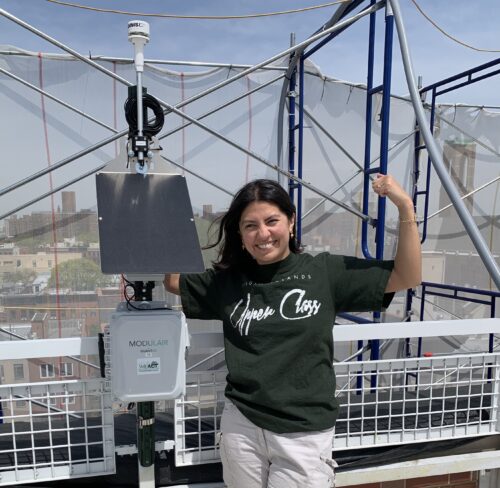Research shows that people of color are exposed to more air pollution and from nearly every source imaginable. This disproportionate exposure has led to higher incidences of adverse health impacts from air pollution. Unfortunately this is true of Northern Manhattan, which has some of the highest asthma rates in the nation.
LIVE: See the Current Air Quality in Northern Manhattan
While the air quality in parts of Northern Manhattan has improved thanks to efforts such as these, we established a network of basic air quality monitors stationed outside the apartments of several community members as well as one outside of our offices on Amsterdam and 152nd Street. Click here to see what our PurpleAir monitors are saying about our current air quality.
We used this citizen science project, WE ACT’s Community Air Monitoring Project (CAMP), to create a baseline to study the affects of congestion pricing on the air quality in Northern Manhattan. Click here to download a presentation analyzing this data by our Capstone students from Columbia Climate School.
In April 2025, we began installing 18 high-end air quality monitors on schools throughout Northern Manhattan. These QuantAQ monitors collect a lot more data, which will provide us with a more robust understanding of the air quality in our community. Click here (and zoom in on Northern Manhattan) to see what our QuantAQ monitors are saying about our current air quality.
WE ACT’s History of Improving Air Quality Northern Manhattan & Beyond
WE ACT for Environmental Justice has a long history of addressing air pollution in Northern Manhattan. In fact, it is part of our origin story.
WE ACT was founded in 1988 to address air pollution from the North River Sewage Treatment Plant. Despite the protest of our activist who would become known as the Sewage Seven, we had to sue the City to have the plant fixed because it wasn’t built up to code. Eventually we achieved a settlement, with $55 million set aside to fix the brand-new plant along with a $1.1 million environmental health fund for the community, that latter of which led to the formation of West Harlem Environmental Action, which we know today as WE ACT for Environmental Justice.
Then we took on the Metropolitan Transit Authority (MTA), which has sited all but one of its diesel bus depots in Manhattan in our community. A U.S. Environmental Protection Agency study at the time showed that the levels of air pollution in a number of Northern Manhattan neighborhoods exceeded proposed federal standards by as much as 200 percent.
In May 1997, we launched our Dirty Diesel campaign to raise awareness of the air pollution produced by the diesel buses in our community and the negative impact on the health or those who live here. The goal of this public awareness program was to convince the MTA to abide by the City’s idling laws, modify its bus depots to accommodate natural gas buses, and to only invest in clean-fuel buses.
Failing to get the desired action, we filed a Title VI Complaint with the U.S. Department of Transportation in November 2000, charging the MTA with violating the civil rights of Northern Manhattan residents. The MTA eventually saw the light, and years later it agreed to retrofit its depots and start investing in diesel retrofits and hybrids. As a result of our campaign, the MTA reduced its bus tailpipe emissions by 95 percent citywide.

